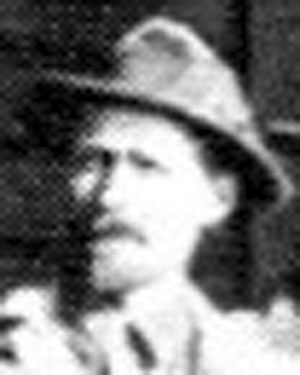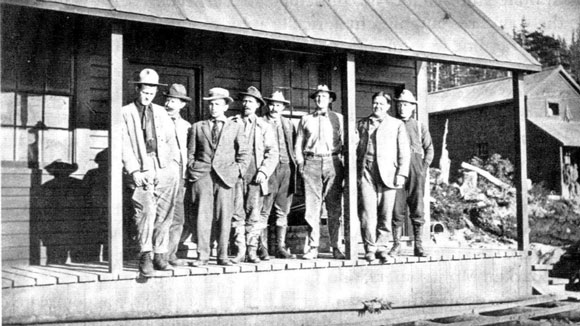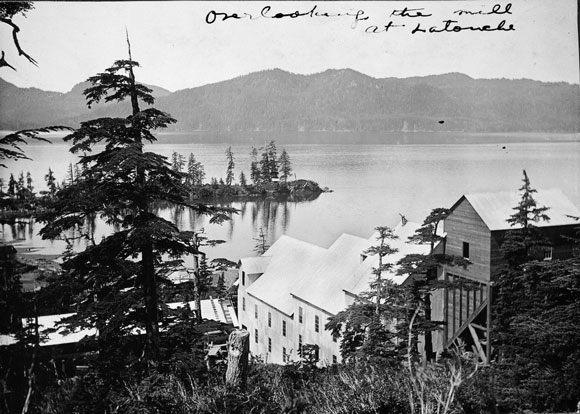William H. Seagrave
1865 - 1929

William H. Seagrave, circa 1911
Source: Helen Van Campen Collection, UAF Rasmusson Library
William H. Seagrave was best known for his skills as an underground mine manager both in the United States and abroad. He played several important roles during the early years of the Kennecott Copper Corporation activities in the Alaskan Territory, both in the Wrangell Mountains and in Prince William Sound.
Details of his birth and childhood have not been researched. His earliest mine-related activities were in the Mother Lode district in the foothills of the Sierra Nevada in California. He worked in California about the same time that Alaska Mining Hall of Fame inductee Thomas Mein was a well-established, large scale, hydraulic, placer gold mine operator in Grass Valley.
In 1895, William Seagrave graduated from the University of Nevada with a degree in mining engineering. After his graduation, California mine promoter and Guggenheim representative John Hays Hammond sent Seagrave along with perhaps twenty five additional personnel to the Robinson Deep mine in South Africa, to oversea it's development. Coincidentally, AMHF inductee Tom Mein was also involved with the Robinson Deep mine as well a few years earlier — mainly representing British financial interest there.
After returning from South Africa, Hammond's successor, Pope Yeatman, promoted Seagrave to several positions of authority to help the Guggenheim mining syndicate establish successful operations in newly acquired properties in North America. In 1906, Yeatman asked Seagrave to reorganize and manage the Veteran underground copper mine near Ely, Nevada. Working as Seagrave's assayer in Nevada was Alaska Mining Hall of Fame inductee Wesley Earl Dunkle, a recent graduate of Yale University.
After that task was completed in 1909, Yeatman sent Seagrave to the newly opened Beatson copper mine in Prince William Sound, one of Kennecott's important Alaska properties. Seagrave and Dunkle must have gotten along because soon afterwards, about 1910, Seagrave asked Dunkle to join him at the Beatson operation, which he did.

Some professional staff standouts when Seagrave was managing the Kennecott mines in Alaska, circa 1911. From left to right, Frank Van Campen, Becker, Richard Watkins, William Seagrave, Stephen Birch, W.E. Dunkle, and 'Shuey' (first names of Becker and Shuey are unknown, Photo Source: Helen Van Campen collection at UAF Rasmussen Library, 74-27-427N
In late 1911, W.H. Seagrave was promoted as general manager, replacing A.B. Emery, of all Kennecott mines in Alaska and moved to Kennecott, Alaska in the rugged Wrangell Mountains. The Copper River and Northwestern Railroad had just been completed, and shipment of copper ores began to make their way from Kennecott to Cordova.
At the onset of production from the Bonanza mine, a number of technological issues had to be addressed. One was underground ventilation. When ventilation was lost in the Bonanza, a potential life-threatening situation was created. Seagrave asked his by-then trusted geologist and mining engineer Wesley Dunkle to hike up to the mine site and repair the problem. Seagrave began to realize how important Dunkle was to the many problem-solving issues that any new industrial enterprise like the Kennecott mines faced. By 1915, Seagrave was so impressed with Dunkle that he asked the latter to assume the position of mine superintendent of the Beatson Mine on Prince William Sound, a job that Seagrave held four years earlier.
As far as Kennecott Copper Corporation was concerned, the principle purpose of the enterprise was to produce copper ores and ship them to the Tacoma smelter as efficiently and quickly as possible. The Kennecott mines in Alaska operated like most other mining enterprises of the early 20th Century. All mine employees worked seven days a week on 12 hour shifts. Breakfast was served at 6:30 AM every day; dinner was served at 6:30 PM. The 4th of July and Christmas were holidays every other day was a work day. Seagrave's management style differed than most managers of his era. Starting in 1912, for his professional staff, Sunday afternoons were off. He later extended this to selected groups of employees like machinists and mill operators — f they caught up with routine maintenance and ore tonnage objectives. These actions resulted in a marked increase in camp morale.

The Beatson copper mine as it appeared in about 1920. Seagrave managed this operation before moving to Kennecott to assume management of all of the company's mines in Alaska. Photo from Helen Van Campen collection, UAF Rasmussen Library.
Seagrave got involved with limiting gambling in the remote camp. Poker was the camp's most popular game. He set financial limits for poker winnings for his professional staff but left them wide-open for the miners. There was no way to police gambling infractions in the remote bunkhouses of the mines and Seagrave didn't try to. His chief concern was trying to limit gambling debt, which could turn into a serious problem for crews in remote locations. Surprisingly, his miners did not object to this intervention.
One important strategic decision that Seagrave wanted to make was acquisition of the Mother Lode deposit, which was developed separately as the Mother Lode Coalition Mining Company--over the hill from the Bonanza deposit. Beginning in 1913, W.E. Dunkle worked with both Stephen Birch and Seagrave to initiate a compilation of geologic and engineering criteria needed to make a decision on the acquisition of the Mother Lode. Action on this important acquisition would await recommendations from a young Yale Graduate and mining consultant, Alan Bateman — an old colleague of Dunkle from Yale (see Bateman biography in this Paystreak). Changes in management necessitated another look at the potential acquisition. Bateman's 1916 recommendations mirrored many of those made Dunkle more than two years previously. The Mother lode would ultimately add another 10 years of life to the Kennecott mines.
William Seagrave left Kennecott in 1916. His exodus was due to the arrival and ascendancy in management of E. T. Stannard, a smart mining engineer that would help the company solve its milling problems. By 1915, the easy-to-mine, massive chalcocite deposits that powered so much of the Kennecott mines in their early years were being depleted, which necessitated the need to improve recovery in lower grade ores — especially the carbonate ores in the Chitistone Limestone. Stannard gained a reputation in the years before his arrival at Kennecott at solving mill problems — first at the Federal Smelting mine in Nevada and later the Braden (El Teniente) copper mine in Chile. He first upgraded the gravity circuits, which improved recovery. His most important contribution was to develop an ammonia leach process to recover copper from copper carbonate ores — a technology that would have applications in other mines worldwide. Stannard definitely proved his worth to the young company.
Kennecott President Birch and Stannard became close. They shared a fondness for paper backup of nearly everything that was going on at the mines, including detailed, daily-to-weekly planning outlines an exhaustive mine map archive and engineering drawings. In contrast, Seagrave knew the location of nearly every item on the mine site, and every man in his organization, but it was all in his head. Seagrave detested paper work.
Stannard made his move in 1916. At the beginning of 1916, Seagrave was general manager at the Bonanza and Jumbo Mines at Kennecott and the Beatson Mine on Latouche Island. Earl Dunkle was Seagrave's superintendent at the Beatson. Stannard was general manager of the mills at both Kennecott and the Beatson. In the summer of 1916, Stephen Birch made Stannard general manager of both mines and mills and William Seagrave was out. Dunkle resigned his position as manager of the Beatson Mine and was replaced. Dave Irwin, who was a class mate of both Dunkle and Bateman, stayed on for a few months but joined Phelps Dodge Corporation in 1917. A near complete turnover in management had taken place.
William Seagrave left Kennecott Copper Corporation in the fall of 1916 but did not yet abandon Alaska. During the early 1920s, Seagrave would begin work on the Nevada-Bellevue copper-silver mine at Contact, Nevada, and later, along with investor W.R. Rust, acquired and equipped the Chichagoff gold mine in Southeastern Alaska. As before, Seagrave brought in W.E. Dunkle to help solve many mine-related issues of both projects. Details of Seagrave's involvement at Chichagoff are not known, but the Nevada-Bellevue mine in Nevada proved to be, for a time, a high grade copper-silver operation. From 1925-to-1930, nearly 2 million pounds of copper and byproduct silver would be won from the Nevada-Bellevue before it closed down due to the crash in copper prices starting in 1929.
W. H. Seagrave would not see the mine shutdown. On February 4th, 1929, Seagrave would die of unknown causes at Long Beach, California.
Although Seagrave's successor, E.T. Stannard would grab the limelight at Kennecott and eventually replace Stephen Birch as CEO of Kennecott Copper Corporation, Seagrave himself left his own mark on the company. He managed the Alaskan mine operations during those crucial, first six years and insured that payback for the expensive and risky mine development was made to company investors. Seagrave exhibited a great persona with his employees, which resulted in high morale of nearly all personnel at the mines. In this enlightened environment, many technical challenges were solved and the camps prospered. The Alaska Mining Hall of Fame honors William H. Seagrave for his important managerial skills during an early era of Alaska's hard rock mining industry.
Editor's Note: This biography was created largely from the published biography of Wesley Earl Dunkle, by Charles C. Hawley in 2003 and 2006 — see below. Additional information was obtained from Hawley's book about the Kennecott mines (also see below)
SOURCES
Hawley, Charles C., 2006, Wesley Earl Dunkle — Alaska's Flying Miner — 2nd Edition: University of Alaska Press, 273 pages.
Hawley, Charles C., 2014, A Kennecott Story — Three Mines, Four Men, and One Hundred Years, 1897-1997: University of Utah Press, 369 pages.